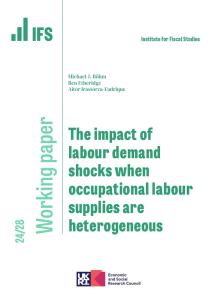There are around 20% more job vacancies than there were pre-pandemic, and that seems to have been stable for 6 months or so now. But new analysis from researchers at the IFS shows that the overall amount of change in the occupational mix of vacancies is no greater than would be expected over a ‘normal’ two-year period. Despite all the turbulence of the past two years the overall mix of vacancies today is remarkably similar to 2019, and has changed no more since then than between 2017 and 2019.
What’s more, in sectors where we have seen big increases in vacancies there is no evidence as yet that this has pushed up wages.
However, if we focus on the changes that have taken place, we find a shift towards vacancies in lower-skilled, lower-paid occupations:
- Vacancies for warehouse workers in the 5 months to February 2022 were more than double their pre-pandemic level, and vacancies for drivers were 80% higher.
- Higher vacancies in some occupations do not appear to have pushed up wages. There is no correlation between vacancy growth between the latter halves of 2019 and 2021 and wage growth over the same period.
- The fact that vacancies have risen most in lower-skilled occupations means that job market opportunities have improved most for low-educated workers. Among unemployed workers without a degree 70% have seen the number of job opportunities for which they might have the appropriate prior experience increase by more than 40%. Fewer than half of those with a degree have seen an equivalent increase in opportunities.
- This means that, while vacancies are high across the board, many of the new opportunities facing jobseekers are in relatively low-paying jobs.
These are among the findings of new IFS research, published today and funded by the Economic and Social Research Council. The research uses data on workers and jobseekers from the Labour Force Survey, and online job vacancy data from Adzuna, up to and including February 2022.
Xiaowei Xu, a Senior Research Economist at IFS and an author of the report, said:
“The pandemic has not led to a huge change in the mix of jobs demanded, but the shift towards lower-skilled occupations is potentially concerning. There are signs that vacancies today are still affected by transitory factors, for example pent-up demand for job moves over the pandemic and the fall in EU migrants, so it is possible that this will fade over time. That said, the specific occupations that have seen large increases in vacancies – drivers and warehouse workers – are consistent with a shift in consumer preferences towards home delivery, which could indicate a more permanent change in labour demand.”










